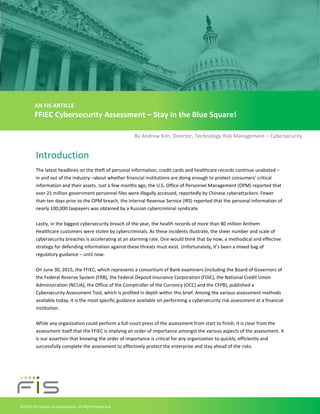
FIS article - FFIEC Cybersecurity Assessment - by Andy Kim - Summer 2015
- 3. ©2015 FIS and/or its subsidiaries. All Rights Reserved. As a boardroom business issue, the Cybersecurity Assessment requires executives to take a methodical approach to assessing the organization’s inherent risk in business terms. Just like the pilot program, it asks specific questions about: Technologies and connection types Delivery channels Online/mobile payments and technology services Organizational characteristics External threats Unlike the pilot program, however, the Cybersecurity Assessment dives further into specifics that provide the following inherent risk ratings: Least Minimal Moderate Significant Most These inherent risk ratings are critical to maintaining awareness of where an organization stands today. It’s the anchor point of how cybersecurity maturity levels relate to institutional risks. The underlying concept here is that the higher the level of inherent risk, the greater the demand is with regard to the sophistication of cybersecurity capability. The tool refers to this as “Maturity.” Maturity is an estimate of the sophistication (or lack thereof) an organization may have in defending against a cyberattack. Maturity is described among five domains: Domain 1: Cyberrisk Management and Oversight Domain 2: Threat Intelligence and Collaboration Domain 3: Cybersecurity Controls Domain 4: External Dependency Management Domain 5: Cyberincident Management and Resilience Each domain is rated at a maturity between: Baseline Evolving Intermediate Advanced Innovative Stay In the Blue Square! To understand how all of this comes together, take a look at this matrix developed by the FFIEC: Page 3 (United States. Federal Financial Institutions Examination Council (FFIEC) Cybersecurity Assessment Tool “Overview for Chief Executive Officers and Boards of Directors”, p. 4, June 2015)
